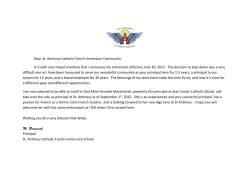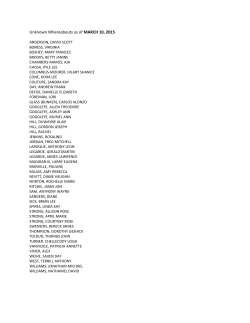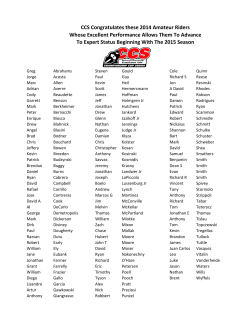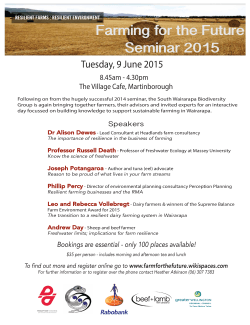
Brought to you by: Melanie Kuzyk, Patrick Waring, and Scott Hanson
Mussels Brought to you by: Melanie Kuzyk, Patrick Waring, and Scott Hanson Source: http://www.dailymail.co.uk/tvshowbiz/article-2601972/Leaked-video-sheds-light-Jean-Claude-Van-Damme-ditched-Arnies-80s-hit-Predator-dodgy-monster-suit.html Outline and Intros ● Introduction to invertebrate fisheries ● Summary of freshwater mussel exploitation ■ ■ Different industries Major lessons ● Critique of paper and issue ● Take-aways ● Discussion Invertebrate Fisheries (Anderson et al. 2011, Eddy et al. 2014)) - Crustaceans, clams, oysters, mussels, sea cucumber, sea urchin, geoduck, scallops, euphausiids - Organisms range in size - Freshwater vs marine - Benthic - Relatively slow-growing; long-lived - Not a lot of focus on invert fisheries - Rapid global expansion - cause for concern Source: http://www.oceansadvance.net/sites/default/files/images/shrimp.preview.jpg Invertebrate Fisheries Year Anderson et al. 2011 Invertebrate Fisheries Anderson et al. 2011 Canadian Crab Fishery ● British Columbia’s commercial crab fishery accounts for 27% of the wholesale value of the province’s wild shellfish products ● On average the commercial crab fleet landed $35.8M per year from 2008 to 2013 ● 221 license eligibilities divided into seven management areas Source: Integrated Fisheries Management Plan Summary http://www.pac.dfo-mpo.gc.ca/fm-gp/mplans/2015/crab-crabe-sm-2015-eng.pdf Source: Integrated Fisheries Management Plan Summary http://www.pac.dfo-mpo.gc.ca/fm-gp/mplans/2015/crab-crabe-sm-2015-eng.pdf Source: Integrated Fisheries Management Plan Summary http://www.pac.dfo-mpo.gc.ca/fm-gp/mplans/2015/crab-crabe-sm-2015-eng.pdf Pacific Oyster ● Commercial licences are responsible for arranging assessment and in-season fishery monitoring services. ● Coastwide commercial total allowable catch (TAC) for 2015 is 808,590 lbs ● 55 total licenses Source: Integrated Fisheries Management Plan Summary http://www.pac.dfo-mpo.gc.ca/fm-gp/mplans/2015/oyster-huitre-sm-2015eng.pdf Source: Integrated Fisheries Management Plan Summary http://www.pac.dfo-mpo.gc.ca/fm-gp/mplans/2015/oyster-huitre-sm-2015eng.pdf Freshwater Mussels Exploitation trajectory of a declining fauna: A century of freshwater mussel fisheries in North America James L. Anthony and John A. Downing 2001 Freshwater Mussels (Zipper et al. 2014) - Unionoida - Freshwater bivalve molluscs - Sedimentary; lakes and rivers - Filter feeders - Unique and complex life cycle Source: Source: http://fishwild.vt.edu/mussel/images/life_history/Colorized-Musselcycle_LG.gif Mussel Life Cycle Source: http://www.ucforlife.se/wp-content/gallery/e-fishing-initial-infestation-experiment_1/5_anodonta-glochidia-on- Freshwater Mussels Freshwater Mussels - Historically, almost 300 species in N. America - Mid-west US, South-east US (Anthony and Downing 2001) - 72% of populations in decline, or worse (Anthony and Downing 2001) - Especially vulnerable to changes in habitat (Haag 2009) Aims of Paper “ Market factors have driven commercial harvests while the life history and ecology of mussels have been largely ignored.” – Anthony and Downing (2001) - Examine broad time frame - Valuable lessons on fishery collapse - Compiled commercial harvest statistics - Yield estimates, commercial value, markets trends, regulatory framework Source: Wikipedia http://en.wikipedia.org/wiki/Mississippi_River Pearl Harvesting Era 1850 - 1900 Source: http://www.fws.gov/midwest/mussel/images/clammers.jpg Pearl Harvesting Era (Anthony and Downing, 2001) Late 19th century - fueled by demand Pearl rush profits > other important US industries Regulated by boom-and-bust trends = unsustainable By 1860 - extensive harvesting occurring in at least 12 states Source: http://www.museum.state.il.us/RiverWeb/harvesting/archives/images/roll9/ba04_450p.jpg Pearl Harvesting Era (Anthony and Downing, 2001) Mid to late 1800s - 13 species harvest extensively Inefficient harvesting methods Rarity drove value up - even more desirable Source: http://www.oftimeandtheriver.org/resources/secondaryimpacts/images/MusselCamp.jpg Pearl Harvesting Era (Anthony and Downing, 2001) Conservation concerns voiced - no actions taken By the early 20th C, North American mussel populations declined due to unsustainable harvesting practices - Urged states to enact protective legislation (Kunz 1893) Mussel Buttons Source: http://busaff.com/movie-quotes/curious-case-of-benjamin-button-quotes/ Source: http://www.oftimeandtheriver.org/resources/secondaryimpacts/images/MusselCamp.jpg Source: http://tennesseeshelldivers.weebly.com/uploads/2/3/9/5/23958470/6757569_orig.jpg American manufacturers had begun to produce buttons from the shells of marine mollusks (Anthony and Downing 2001) Johann Frederic Böpple (Anthony and Downing 2001) 3,180 tonnes of shells (Anthony and Downing 2001) http://squishable.ca/squishable-blue-whale.html 3,306 tonnes were harvested (Anthony and Downing 2001) http://squishable.ca/squishable-blue-whale.html - 21,628 tonnes of mussel shells - $23,000,000 (Anthony and Downing 2001) http://squishable.ca/squishable-blue-whale.html Source: http://www.science.calwater.ca.gov/images/scinews_0410_brain_01.j Japanese button manufacturers entered the American button market (Anthony and Downing 2001) Fairport Biological Station of the U.S. Bureau of Fisheries was established to answer concerns about depleting mussel stocks (Anthony and Downing 2001) Minnesota and Illinois adopted protective regulations (Anthony and Downing 2001) The industry’s peak production year, the U.S. produced over 5.75 billion buttons valued at over $175 000 000 (Anthony and Downing 2001) Wisconsin and Iowa adopt similar restrictions including restrictions on size, means of capture, and licensing fees (Anthony and Downing 2001) Some recovery noted in populations (Anthony and Downing 2001) Ruh roh Williams et al. 1993 Cultured-Pearl Industry How Is a Pearl Made? http://kids.britannica.com/comptons/art-53775/Some-irritant-such-asa-grain-of-sand-gets-into How Is a Cultured Pearl Made? http://www.blackbeltmag.com/daily/martial-artsmasters/fumio-demura/shito-ryu-karate-trailblazer-fumio- http://www.imperialpearl.com/imperial/Pearl-education/Tahitian-CulturedPearls.asp Beginning of Pearl Nuclei Demand -US Shell Exports increase -Upwards of 10% of freshwater mussel industry (Claasen 1994) 1960 Fusconaia and Pleurobema spp. regarded as best nuclei substrate in the world (Claasen 1994) 1962 - Musselers on the Tennessee River expect around 180kg of mussels per day 1965 - Tennessee river supply exhausted - Wabash River peak harvests at 900t/annum 1968 - US shell exports exceed 22,000t annually 1970 - 1980 - Mass die-offs noted in the upper mississippi (upper and lower), Tennessee, Wabash - Numerous streams at exhaustion and collapse levels (Anderson et al. 1993) 1970 - 1980 - Lack of supply for Fusconaia and Pleurobema spp - Megalonaias nervosa becomes new species of choice (Fassler 1994) 1980 - 1990 Mussel Catch 1990 - 2000 Year 2000 - Present day Cultured-pearl nuclei industry by far the dominant driver of freshwater mussel industry in US (Nagai 2013) - Cultured Pearls make up 90% of pearl sales worldwide (Southgate and Lucas 2011) - Lessons (Anthony and Downing, 2001) 1. Short-term economic decisions can impede long-term resource sustainability 2. Basic biology and ecology sets the upper limits for harvest intensity - Historical mussel declines largely due to sedimentation, toxins (Ortman 1918) Lessons (Anthony and Downing, 2001) 3. Loss of exploited populations depends on the rate of harvest relative to the rate of production (Anthony and Downing 2001) Lessons (Anthony and Downing, 2001) 4. Delays in resource management and regulation may be dangerous to resource viability Watch out or imma over exploit this tree num num num Source: http://www.knt.co.jp/ec/2011/icft/plenary_lectures.htm Lessons (Anthony and Downing, 2001) 5. Declining economic viability does not predict future resource uses NO ONE CAN TELL THE FUTURE!!!!!!! Source: http://profiles.forestry.ubc.ca/person/scott-hinch/ Lessons (Anthony and Downing, 2001) 6. Poor resource management favors competitors If you’re not first you’re last Source: http://www.pac.dfo-mpo.gc.ca/science/facilities-installations/pbs-sbp/mgl-lgm/geno/collab/index-eng.html Lessons (Anthony and Downing, 2001) 7. Overexploited resource yields show unpredictable behaviours Year Lessons (Anthony and Downing, 2001) 8. Intensive harvest of overexploited resources degrades population renewal potential Recruitment overfishing! http://1.bp.blogspot.com/-3L8Eok8PyjY/TbGEVIrJiKI/AAAAAAAAq7A/1Yas-fZQfwc/s320/%257Eshinch.jpg Lessons (Anthony and Downing, 2001) Fishing down the ladder right guys? 9. Intensive harvest can lead to progressive reductions in biodiversity http://news.ubc.ca/2009/02/05/archive-ubcreports-2009-09feb05-genomics/ Critiques Historical stats not always reliable - Stats based on marketable products - not bycatch - License holders only recently obligated to report yields - Mussel harvesting before the 1800s (Haag 2009) Critiques - Claim historical “regulatory vacuum” (Anthony et al. 2001) - Freshwater Mollusk Conservation Society (est.1992) - Academic alarms (Williams et al. 1993, Cope and Waller 1995) Critiques - Barely address associated impacts of habitat degradation (pollution, siltation, channelization, impoundment, dredging, dams) - Hybridization - Invasive species (Zebra Mussel, Asian Clam) Critiques - Impacts of dams on Mussel populations (Watters 1996) - Channelization (Williams et al. 1993) Dredging (Williams et al. 1993) Pollution (Bogan 1993) Siltation (Augspurer et al. 2003) Impoundment (Ricciardi 1998) Hybridization (Williams et al. 1993) Critiques - Invasive Species - Zebra Mussel - Established 1991 Invasive or filling a niche? (Strayer et al. 2004) - Asian Clam - First introduced 1930s Impact differs temporally and geographically (Cherry et al. 2005) http://en.wikipedia.org/wiki/Zebra_mussel Current Status - Currently over 70% of freshwater mussels species in North America are extinct or imperiled (USFWS 2015) Current Industry - 18 American States currently exporting freshwater shells - Worth upwards of $13 Million USD/annum - Chinese entrance into industry Current Research • Still no extinctions in Pacific Northwest or upper Mississippi River basin (Haag 2009) • Extinction debt (Haag 2009) • Mussel research largely increasing since the 1990s (Strayer et al. 2004) • Gaps still exist, but conservation actions should not be postponed (Strayer et al. 2004) Current Research • Restoration, relocation and re-introduction (Carey et al. 2015) • Hydroelectric Impacts • Introduced spp. (Johnson and Mhatre 2014) (Haag 2012) • Pollution Impacts (Price et al. 2014) Current Research Re-introduction (Cope and Waller 2006) Protected areas (Saunders et al. 2002) Protected species status (USFWS State to state (Carey et al. 2015) http://funny-pictures.picphotos.net/wu-tang-clam/bite-prod.s3.amazonaws.com*wpcontent*uploads*2012*05*Wutang-Clam-05-NUTTIN.jpg/ How did this Happen? “Don't stop thinking about tomorrow Don't stop, it'll soon be here It'll be, better than before, Yesterday's gone, yesterday's gone” – Fleetwood Mac, ‘Don’t Stop’ ASK YOUR QUESTIONS Questions Which lesson do you think is the mosty important? Can you find any parallels between the overexploitation of freshwater mussels and a current fisheries industry? Questions How will mussel extinction debt affect other species? Which industry, of the three presented, has had the largest effect on freshwater mussels? What do you think are barriers to the conservation of freshwater mussels? Questions What aspects of freshwater mussels life history could prove difficult in conservation attempts? Did economic viability play a role in the conservation of freshwater mussels? How will increase in the Chinese economy affect the mussel populations in the USA? Questions Has technology been beneficial or detrimental to the conservation efforts of the freshwater mussel? References Anderson, R.M., Stefanavage, T., and Flatt, T. 1993. Why did Indiana halt commercial mussel harvest in 1991? In Conservation and management of freshwater mussels. Proceedings of a UMRCC symposium, 12–14 October 1992, St. Louis, Mo. Edited by K.S. Cummings, A.C. Buchanan, and L.M. Koch. Upper Mississippi River Conservation Committee, Rock Island, Ill. pp. 19–24. Anderson, S.C., J.M.Flemming, R. Watson, and H.K. Lotze. 2011. Rapid global expansion of invertebrate fisheries: trends, drivers, and ecosystem effects. PLoS ONE 6: e14735 Anthony, J.L. and J.A. Downing. 2001. Exploitation trajectory of a declining fauna: a century of freshwater mussel fisheries in North America. Canadian Jounral of Fisheries and Aquatic Sciences 58: 2071-2090. Augspurger, T., A.E. Keller, M.C. Black, W.G. Cope and F.J. Dwyer. 2003. Water quality guidance for protection of freshwater mussels (Unionidae) from ammonia exposure. Environmental Toxicology and Chemistry 22: 2569 – 2575. Bogan, A.E. 1993. Freshwater Bivalve extinctions (Mollusca: Unionoida): A search for causes. American Journal of Zoological Sciences 33: 599 – 609 More References Bradsher, K. 2011. Pearls, finer but still cheap, flow from China. The New York Times. Available online at: http://nyti.ms/1BBN9HV Carey, C.S., J.W. Jones, R.S. Butler and E.M. Hallerman. 2015. Restoring the endangered oyster mussel (Epioblasma capsaeformis) to the upper Clinch River, Virginia: an evaluation of population restoration techniques. Restoration Ecology 33: 1 – 8. Cherry, D.S., J.L. Scheller, N.L. Cooper and J.R. Bidwell. 2005. Potential effects of Asian clam (Corbicula fluminea) die-offs on native freshwater mussels (Unionidae) I: water-column ammonia levels and ammonia toxicity. Journal of the North American Benthological Society 24: 369 – 380. Even More References Claassen, C. 1994. Washboards, pigtoes, and muckets: historic musseling in the Mississippi watershed. Historical Archaeology, 28: 1–145. Cope, W.G. and D.L. Waller. 1995. Evaluation of freshwater mussel relocation as a conservation and management strategy. Regulated Rivers: Research and Management 11: 147 – 155. Eddy, T.D., M. Coll, E.A. Fulton, H.K. Lotze. 2014. Trade-offs between invertebrate fisheries catches and ecosystem ipacts on Coastal New Zealand. Fisheries Centre Research Reports 22: 56-57. Fassler, C.R. 1994. The American mussel crisis: effects on the world pearl industry. In Conservation and management of freshwater mussels II. Proceedings of a UMRCC symposium, 16–18 October 1995, St. Louis, Mo. Edited by K.S. Cummings, A.C. Buchanan, C.A. Mayer, and T.J. Naimo. Upper Mississippi River Conservation Committee, Rock Island, Ill. pp. 265–277. MORE AND MORE REFERENCES Fish and Wildlife Service, US Department of the Interior. http://www.fws.gov/midwest/endangered/clams/mussels.html Haag, W. 2009. Holocene extinctions in the sea. In: Holocene Extinction, S.T. Turvey (ed.). Oxford University Press, New York. Johnson, A and S. Mhatre. 2014. Water for electricity in the Upper Savannah Basin: impacts on Freshwater Mussels. Graduate Research and Discovery Symposium (GRADS). Paper 115. Kunz, G.F. 1983. On the occurrence of pearls in the United States: shall we legislate to preserve the fisheries? American Fisheries Society , New York: 33-34. Nagai, K. 2013. A history of the cultured pearl industry. Zoological Science 10: 783 – 793. Natural Resources Conservation Service (NRCS). 2007. Native Freshwater Mussels. Fish and Wildlife Habitat Management Leaflet 47: 1 – 16. SO MANY REFERENCES Price, J.E., C.E. Zipper, J.W. Jones and C.T. Franck. 2014. Water and sediment quality in the Clinch River, Virginia and Tennessee USA, over nearly five decades. Journal of the American Water Resources Association 50: 837 – 858. Ricciardi, A., R.J. Neves and J.B. Rasmussen. 1998. Impending extinctions of North American freshwater mussels (Unionoida) following the zebra mussel (Dreissena polymorpha) invasion. Saunders, D.L., J.J. Meeuwig and A.C.J. Vincent. 2002. Freshwater protected areas: Strategies for conservation. Conservation Biology 16: 30 – 41. Strayer, D.L., J.A. Downing, W.R. Haag, T.L. King, J.B. Layzer, T.J. Newton, and S.J. Nichols. 2004. Changing perspectives on pearly mussels, America’s most imperiled animals. BioScience 54: 429-439. Strayer, D.L., J.A. Downing, W.R. Haag, T.L. King, J.B. Layzer, T.J. Newton and J.S. Nichols. 2004. Changing perspectives on pearly mussels, North America’s most imperiled animals. BioScience 54: 429 – 439. END OF REFERENCES Watters, G.T. 1996. Small dams as barriers to freshwater mussels (Bivalvia, Unionoida) and their hosts. Biological Conservation 75: 79 – 85. Williams, J.D., M.L. Warren Jr, K.S. Cummings, J.L. Harris and R.J. Neves. 1993. Conservation status of Freshwater Mussels of the United States and Canada. Fisheries 18: 6 – 22 Zipper, C.E., B. Beaty, G.C. Johnson, J.W. Jones, J.L Krstolic, B.J.K. Ostby, W.J. Wolfe, and P. Donovan. 2014. Freshwater mussel population status and habitat quality in the Clinch River, Virginia and Tennesse, USA: a featured collection. Journal of the American Water Resources Association 50: 807-819
© Copyright 2025










